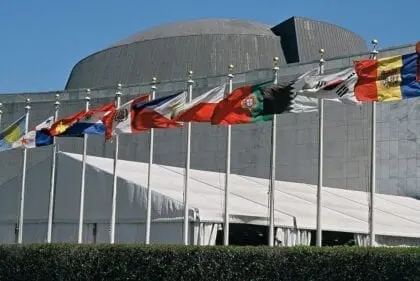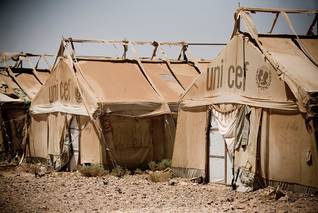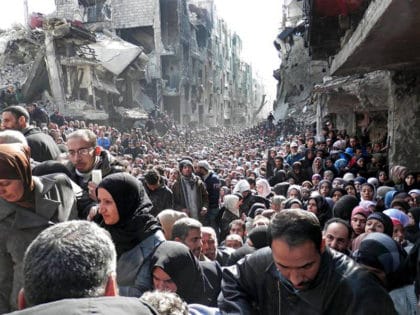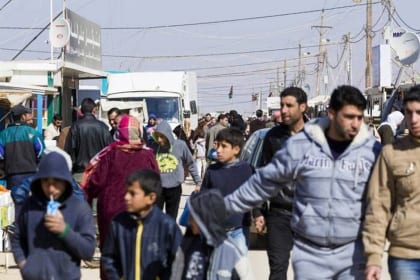
Introduction
As the Middle East and North Africa have been affected by several crises, including conflicts, violence, disasters, and climate change, the region has seen huge waves of migration in its history. People have been forced to leave their homes and cross international borders as refugees. Those who could not flee their country ended up being stuck inside their countries as Internally Displaced Persons (IDPs). As a result of masses of people crossing borders, the neighboring countries have had to cope with the massive number of refugees. For more details, check the map above.
Palestinians
One of the first groups of refugees that emerged in the region were the Palestinians, who from 1947 onwards (with a peak after the Arab-Israeli War of 1948-1949) fled their homes in Palestine to Jordan, Lebanon, Syria, Iraq and to a lesser extent to the Gulf states. Most of them ended up in refugee camps set up by the United Nations Relief and Works Agency for Palestine Refugees in the Near East (UNRWA), where they and their descendants still live. Their legal status varies from a foreigner (Lebanon) to a citizen (part of the Palestinian refugee population in Jordan).
To learn more about why the Palestinians had to flee their homes, please see Fanack’s file on the Palestinian-Israeli conflict.
Syrians

Hundreds of thousands of these Palestinians living in Syria met the same fate again when the conflict in Syria erupted. This crisis produced the biggest wave of migration in the region and one of the worst humanitarian crises in the world. Since March 2011, an estimated 13.5 million people (about half of the country’s population) have been forced out of their homes.
More than 5.63 million Syrians have fled across the border to Turkey, Lebanon, Jordan, Iraq and Egypt, as of August 2021. The total number of Syrian refugees stood at 6.7 million at the end of 2020, according to figures provided by the United Nations High Commissioner for Refugees (UNHCR).
Initially, most Syrians found refuge in overcrowded refugee camps in neighbouring countries (around 48 per cent of Syrian refugees in January 2013). The rest went on to stay in urban or rural areas. This picture has changed from 2013 onwards. As of August 2021, around 95 per cent of all registered refugees lived outside the camps, with just 5 per cent of refugees remaining there.
However, that does not mean that the camps have been deserted. The number of people living there has almost doubled in eight years, from around 150,000 in January 2013 to more than 278,000 in July 2021. At their height, in July 2016, the refugee camps were home to almost 495,000 Syrians.
To learn more about how life has been for Syrian refugees both in and outside the camps, click here.
The internally displaced people in Syria have been victims of violence and subject to sieges imposed by regime and opposition forces, blocking all access to aid. For this reason, many described them as one of the most vulnerable people. According to the UNHCR, the number of IDPs increased more than tenfold in nine years, from 600,000 persons in 2011 to more than 6.5 million in 2020.
Yemenis and Others

Khaled Ziad / AFP
While Syria has the largest IDP population in the region, the number of IDPs in war-torn Yemen also increased dramatically in less than ten years, from 464,000 in 2011 (after the “Arab Spring” had just erupted there) to 3,65 million in 2020.
While the number of refugees registered with UNHCR is relatively low at around 33,000 in 2020, hundreds of thousands of Yemenis fled the country at the onset of the conflict between the Saudi-UAE-led coalition and Houthi rebels. Most Yemenis who could flee went to the Horn of Africa and settled in Somalia, Djibouti, Sudan and surrounding countries.
Before the war, Yemen already hosted hundreds of thousands of refugees, including more than 200,000 refugees from Somalia. Despite the desperate situation, more refugees, among them Eritreans, Ethiopians and to a lesser extent, Sudanese, have entered Yemen.
Yemen is the only country on the Arabian Peninsula that ratified the 1951 Refugee Convention, and refugees are thus accepted. Meanwhile, Yemenis themselves have found it much harder to find refuge in neighbouring countries.
Iraq and Afghanistan have also been enormous sources of refugees in the region. The same applies to Sub-Saharan countries such as South Sudan and Eritrea.
Other countries with a high number of IDPs are Sudan (2.6 million), Iraq (1.2 million), and Libya (278,177) (Source: UNHCR, 2020).
Socio-economic Impact of Refugees
The impact the waves of refugees have had on the receiving countries reflects inequality in the Middle East and North Africa. On the one hand, some of the poorest countries have had to cope with most refugees in the region. On the other hand, the wealthiest countries host the least number of refugees.
The map above shows the socio-economic impact of refugees on the host countries, as defined by the number of refugees per $1 GDP per capita.
As seen on the map, the countries bearing the highest refugee burden are Sudan, Turkey, Lebanon, Jordan, Iran and Yemen. At the same time, these countries have a low GDP per capita, which makes the socio-economic impact of refugees there high.
In contrast, the wealthiest countries in the region – Gulf states like Qatar, Saudi Arabia and Kuwait – host the smallest number of refugees. Considering that they are far from the conflict zones, these countries have traditionally accepted far fewer refugees than others in the region. However – and this is still the case with the Syrian refugee crisis – they are also less willing to give refuge to those fleeing war or oppression, which has drawn criticism from human rights organizations like Amnesty International.
None of the Gulf countries has signed the 1951 UN Convention relating to the Status of Refugees, so they are not obliged to accept refugees. However, other countries that have not signed the convention – Iraq, Jordan, Lebanon, Syria and Libya – have accepted refugees.
Some of the reasons these countries have put forward for their reticence are fears of (further) demographic imbalance, sectarian unrest or terrorism and job competition for their populations. According to Saudi officials, the kingdom has accepted some 2.5 million Syrians since 2011.
However, Saudi Arabia neither dealt with these Syrians as refugees nor accepted having them under the auspices of the UNHCR. Instead, it dealt with them as “guests”. Syrians can only enter Saudi Arabia at the invitation of family members already living there.
Other ways to measure the burden of refugees on host countries – e.g. comparing the refugee population with the total population or with the country’s surface area – may provide a skewed picture. In many host countries, refugees are concentrated in camps or cities, rather than being evenly distributed over the national territory, like in Jordan.
Comparing the number of refugees with the total surface area does not take into account the fact that large areas of a country may not be available for productive use, like the deserts in Saudi Arabia and Sudan.
It has to be noted, however, that refugees not only represent a burden to the host countries but can also contribute to the economy if they are allowed to integrate into society. Although the Lebanese economy has suffered from the implications of the civil war in Syria, the presence of Syrian refugees has partly compensated for the economic loss, according to the Brookings Institute.
Refugees have been an important source of demand for local services, which has boosted sectors including trade, real estate and tourism that have been adversely affected by the spill-over from the civil war. These benefits do not necessarily guarantee a warm welcome, however. The Lebanese government, like the Jordanian government, has stressed the negative impact of Syrian refugees and introduced measures to curb the flow.
Number of refugees per 1000 inhabitants
Source: UNHCR. For a correct reading of the graph, consider that the figures inserted for each country reflect the most recent data available. Lebanon data are from 2015; Algeria 2017; Jordan 2018; Kuwait 2019; Sudan, Iran and Israel (2020); Libya, Turkey, Egypt, Tunisia and Morocco 2021.
Refugees Population by Country of Origin
Lebanon (2015)
Source: UNHCR
Turkey (2021)
Iranian (980) and Iraqi (1000) refugees make up a minor part of the total number of refugees and are therefore not visible in the pie chart. Source: UNHCR
Sudan (2021)
Source: UNHCR
Iran (2020)
Source: UNHCR;The breakdown is based on UNHCR’s estimates.
Yemen (2021)
Source: UNHCR
Jordan
Source: UNHCR



















